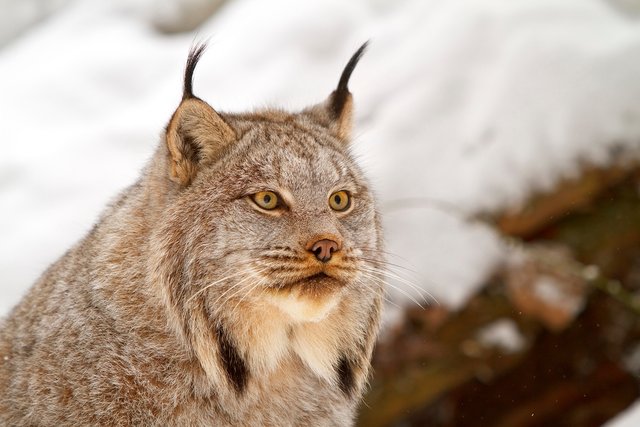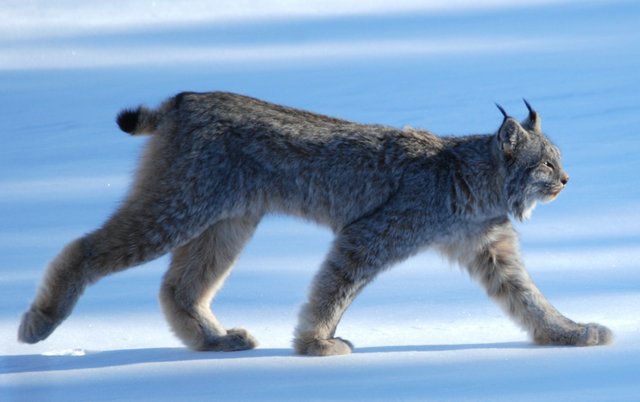Conservation success stories #1: Reintroducing the Canada lynx (Lynx canadensis) back to the mountains of Colorado
Although it carries the name Canada lynx (Lynx canadensis), this feline is not endemic to Canada. The Canada lynx’s range actually crosses into the United States, both to Alaska in the north, and through the Rocky Mountains to the state Colorado in the south.

Image by Michael Zahra, posted with the Creative Commons Attribution-Share Alike 3.0 Unported license.
The Canada lynx has been the apex predator in the mountains of Colorado for a long time, but like many other large mammals, it experienced a sharp population decline once humans became good hunters. Its population size kept shrinking during the 20th century, and by the late 1970s it was considered to be locally extinct in all of Colorado. The culprits were mostly hunters who put out traps, but they were also affected by habitat destruction and habitat fragmentation due to humans beginning to utilize the area.
The lynx still thrived further north, but its absence from the Rocky Mountains had noticeable effects on the local ecosystem that now lacked one of the major apex predators in the region. This meant that animals such as snowshoe hares (Lepus americanus), voles and other small mammals would see increased population numbers, which could lead to diseases spreading, too many plants being eaten, and other harmful effects for the ecosystem.
Reintroduction to the Colorado mountains
After being gone for over 20 years, the Colorado Parks and Wildlife had had enough, and began a conservation campaign where they wanted to reintroduce the Canada lynx to the wild mountains of Colorado.

Image by Keith Williams, posted with the Creative Commons Attribution 2.0 Generic license.
The reintroduction program began in 1999 when 96 wild lynxes were released in the region. From this point onwards the Colorado Parks and Wildlife kept releasing wild lynxes, and by 2006 they had released a total of 218 lynxes that were all originally caught in the wild in Alaska or Canada.
The goal behind the releases was to establish a sustainable population, which could then reproduce and thrive in the region without depending on additional releases from the group.
All the released lynxes were equipped with very high frequency (VHF) and/or satellite transmitters in order for scientists to monitor their activity, and could learn more about mortality rates, reproduction, habitat use, and movement patterns from this equipment.
The status of the conservation program today
It’s been a good while since the last lynx was released in 2006, and while it is still too early to know about the long-term viability of the population, preliminary reports are looking good. According to the newly released Reversing America’s Wildlife Crisis: Securing the Future of Our Fish and Wildlife by the National Wildlife Federation, the American Fisheries Society and The Wildlife Society, the program is considered a success so far.

Image by Michael Zahra, posted with the Creative Commons Attribution-Share Alike 3.0 Unported license.
The number of lynxes that are currently living in Colorado is believed to be between 150 and 200 animals, which is a bit lower than the amount released, but the population has shown to be reproducing and thriving despite this. Some lynxes have been confirmed to have been poached, and some people believe that it is the work of illegal fur poachers due to the fact that only the radio collar was found on the “crime scene”.
Thanks for reading
The Canada lynx population in Colorado seems to be doing fine, and would probably grow in numbers if someone is able to stop the illegal hunters in the area, so it’s a nice example of how a conservation program has been able to reintroduce a pretty big animal back into a region where it was originally locally extinct. I’ve use the scientific article "Evaluating the Canada lynx reintroduction program in Colorado: patterns in mortality" by Olivier Devineau et. al. as the primary source for this post, so check it out to learn more.
The «Conservation success stories» series
The Conservation success stories series focus on brining the good news about conservation biology, where actions made by us humans have led to reintroductions, increasing population sizes, or stopped an extinction process. I believe that this series is very important because conservation biology is usually filled to the brim with bad news, so it is important to remember that some efforts actually do pay off.
About @valth
Hey, I'm @valth - the author of this post. I love to write about nature, biology, animals, nature conservation, ecology and other related branches of science, and I occasionally write about my life, about Steem or about random stuff as well. I'm trying my best to write at least one post every day, so make sure to give me a follow if you enjoy my content and want to see more of it.
Join the @valth community!
I love nothing more than to engage with my readers, so please join the @valth community in the comment section. You will definitely find more information about the topic, personal experiences, questions, and even opposing views down there, so don't miss out on learning more.
I always reward users who post good comments, so please take the opportunity to share your views and get a small upvote in exchange for it.
Nice story @Valth
I was actually on a trip to the cost to day and on my way out I stumbled upon some Lynx footprints in the snow. Tried to follow them for a while, but the snow have started to melt so lost the track after a couple of hundred meters.
It would have been really cool to se a Lynx in this area since it has been 5-6 years since I saw a wild one.
Wow, that sounds really cool! The lynx in Norway tend to stay pretty close to its home range, so it probably lives in the area. I have never seen one in the wild despite living in areas with lynxes most of my life, so I can only imagine how cool it must have been to see one! Did you get a photo of it?
I bet after the releasing, the fauna changed a lot. It's known that when predators are released at a determined place they control the population of their prey (mostly ruminants), and it helps the vegetation to grow (because the demand of food is more low), and also other species of animals lower in the food chain get benefited from the new environment, aerate the soil, and this way also rivers and streams work better improving aquatic life and predators that feed on fish. Nature is just amazing :)
Dad joke that came to my mind: "It's better to be on the BLOCK-CHAIN than destroying the FOOD-CHAIN" (lol)
Yeah, restoring the original ecosystem was one of the major reasons why they even wanted to reintroduce them, and rabbits and other small herbivores had gotten really out of control after the lynxes were originally exterminated from the area. It's such an intricate interconnection between most species!
Look how beautiful they are...Why would anybody want to kill such a lovely creature... Poachers are really a menace!!!!
Good to know that conservation efforts are being fruitful!!!
Yeah, they are adorable. Sadly their fur is also very lovely, and some stupid people would rather have it in their closets or on their walls instead of on the animal it belongs to..
Nice one @valth
All these creatures which live in cold condition or snow are generally been captured or slautered may be for their skins some these cats families are almost extinct eg. Snow leopard. There conservation is relly important or our next coming generations wont be seeing any of these creatures.
Yeah, these guys were hit hard by the fur poachers in the last century, and still sees some of them. It would be very sad if these big mammals were to go extinct, but luckily it does not seem like there is an immediate threat :)
Great effort by conservationist to reintroduce Canada lynx in Colorado. Population of 2006 was 218 and now it's 150-200 good going despite being hunted for fur. Hopefully local government will do strict action for conservation of cute Canada lynx and help to develop better eco system. keep sharing @valth
Yeah, I hope so as well. I think there are pretty strict laws against poaching them, but it can also be difficult to find out who did it :(
Indeed it's a difficult task to find out the culprit but strict action should be taken to control the situation. Close circuit camera may helpful in this regard. Only stringent control produce the better result. Let's hope for the best
With all the problems we've created , it's good to share the good things some of us have done as well.
I hope the Canadian lynx thrives under the new conservation program.
Yeah, that was exactly what I was thinking. I hope to do some more of these positive posts every once in a while from now on :)
Human and animal are complementary of each other.... Hope that this problem will solve soon and canadian lynx will survive human ...
Yes, I agree. What problem do you mean?
Abundance of animal in a fixed area is worst for those are...
To listen to the audio version of this article click on the play image.

Brought to you by @tts. If you find it useful please consider upvote this reply.
I have came across this canadian lynx for the first time.
Its more like cat
Yeah, they are pretty closely related to the cats :)
This is so sad. I hope that the people would care more about the environment and about it's wildlife. Great post as usual @valth I see that you are very responsive with comments on your posts but it would be nicer to see you around the community leaving constructive feedbacks or comments to other steemstem users. 😉

Hi @sakura1012. Thanks for stopping by! I'm glad to hear that you liked my post.
I've already been called out by @physics.benjamin earlier for not engaging enough with other SteemSTEM member, and I'm trying to improve. I did write a handful of comments yesterday, so at this point I'm really starting to wonder what you guys expect from me? @physics.benjamin told me on Discord that he expected me to interact by commenting and giving feedback to a few other authors each day, which sounds reasonable, but is this not enough anymore?
Reading and writing a handful of comments do take some time, especially when I want to comment something better than just "nice post" (which adds nothing of value in my opinion), and I honestly have absolutely no way to spend more than an hour or so on reading other posts.
While I love the #steemstem community, I now see that you guys might be expecting more from me than I am capable of providing.
Sorry for the rant, but it's getting very frustrating to get all this negative feedback when I feel like I am already spending a lot of time on the exact thing you expect me to do more of..
Best regards from @valth
I truly understand what you feel @valth. I dont really feel that you are ranting instead I do think expressing what you feel and sharing your sentiments are very healthy for us and for the community. Everybody can work on improving one step at a time. Looking forward for your next amazing posts 😀🌸